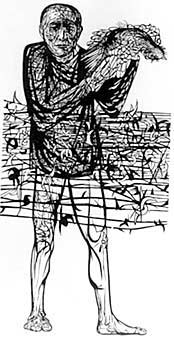Oregon Jewish Museum and Center for Holocaust Education
October 8, 2023 – January 21, 2024
Leonard Baskin’s Orthodox Jewish upbringing and his deep knowledge of Jewish texts and history are evident throughout his oeuvre. Other important influences include monumental Egyptian and Mesopotamian sculpture and Greek mythology and literature. Always a representational artist, Baskin’s images in every media confirm his deep engagement with the natural world of birds, animals, insects, and plants. However, it is commitment to the human figure and its fate in a world of turmoil and suffering that is preeminent in his work.
Leonard Baskin, The Great Birdman features more than 70 works from the collection of Judith Baskin and Warren Ginsberg and is guest curated by Kenneth Helphand, Philip H. Knight, Professor of Landscape Architecture Emeritus, University of Oregon and Judith Baskin, Philip H. Knight Professor of Humanities Emerita at the University of Oregon.
Being Jewish confounds things. The people of the book are intelligently defined as a religion. I, a believing atheist, proudly declare my Jewishness. It is to Yiddish that my spirit warms; to that heritage of persecution and sensual denial, that Yiddish so richly expresses. Not religion, but religious texts: not beliefs or superstition, fear or malignant custom, but the literacy, artistic, cultural and human relics of that religion.
Leonard Baskin
Leonard Baskin (1922-2000) was born in New Brunswick, NJ, the second child of Rabbi Samuel and May Guss Baskin. In his childhood the family moved to Brooklyn, New York. He attended Yale University, before serving in the US Navy in the Second World War; he finished his undergraduate degree at the New School for Social Research in New York City. Between 1950 and 1952 he studied in Paris and Florence and between 1953 and 1974 he taught sculpture and printmaking at Smith College in Northampton, Mass. Baskin received many honors and awards throughout his career and six honorary doctorates.
One fair day, I chanced upon the shelves laden with books by and about William Blake. Confronting Blake plain and unexpected was like being struck by a locomotive. Here was the model, praxis, paradigm and example, an artist and poet coupled. He made his own strange and marvelous books, their impact was overwhelming and I determined to learn to print.
Leonard Baskin
William Blake’s combined commitment to words and images spurred Baskin to found the Gehenna Press, one of the first fine art presses in the United States. A line from Paradise Lost by English poet John Milton inspired the name of the press: “And Black Gehenna call’d, the type of Hell” (1:405). Initially a novice in printing, Baskin learned and taught others the complex artistry involved. These included typographic variations, selecting quality papers, and binding techniques. He did not operate alone but worked with skilled printers who became part of the staff of the press. The press published works by classic writers, including Euripides, Shakespeare, Robert Burns, Emily Dickinson, Herman Melville, Hart Crane, William Morris, and Walt Whitman, as well as contemporary writers and artists, such as James Baldwin, Stanley Kunitz, Archibald MacLeish, and Baskin’s good friend and frequent collaborator Ted Hughes. Books published by the press sometimes featured illustrations by Baskin as well as other artists. In 1992, a 50-year retrospective of Gehenna Press books toured the country, including a major exhibition at the Library of Congress.
On the collection of work on view at OJMCHE, Judith Baskin, the artist’s niece, notes, “This is very much a family assemblage and its contents have come to me and my husband, Warren Ginsberg, often piece by piece, over many years. Leonard Baskin, my father’s younger brother, was immensely generous. He was always amenable to helping family and friends celebrate life cycle events, creating invitations and birth announcements, often in his beautiful Hebrew calligraphy. Some of the works on display here were given to me or to Warren and me directly by my uncle; others originally belonged to my paternal grandparents, my maternal grandmother, or to my parents, Rabbi Bernard and Marjorie Shatz Baskin.”
IMAGES
Self Portrait
Self Portrait at 59, Lithograph, 1981. :copyright:Estate of Leonard Baskin
Tobias and the Angel 1958
Tobias and the Angel, Wood engraving, 1958. ©Estate of Leonard Baskin
Romeyn De Hooghe
Romeyn de Hooghe (1645–1708)
Wood engraving, 1968
Short Bull, Sioux (1845–1923)
Short Bull, Sioux (1845–1923), Lithograph, 1974)
Wood engraving, 1968
Red Cloud Oglala
Red Cloud, Oglala (1822–1909)
Lithograph, 1993
Yom Kippur Angel
Yom Kippur Angel, Etching and aquatint, 1978. OJM2017.43. ©Estate of Leonard Baskin, Image Courtesy R. Michelson Gallery







